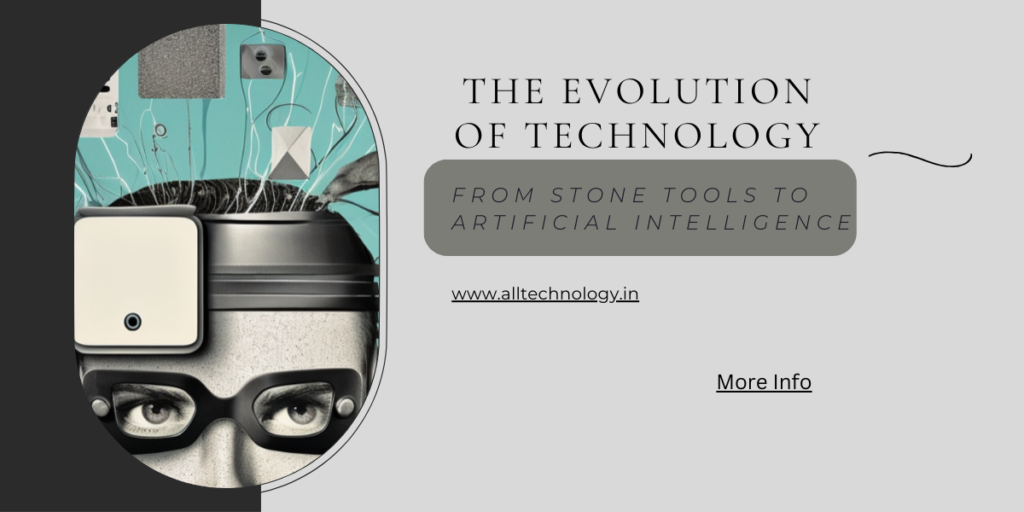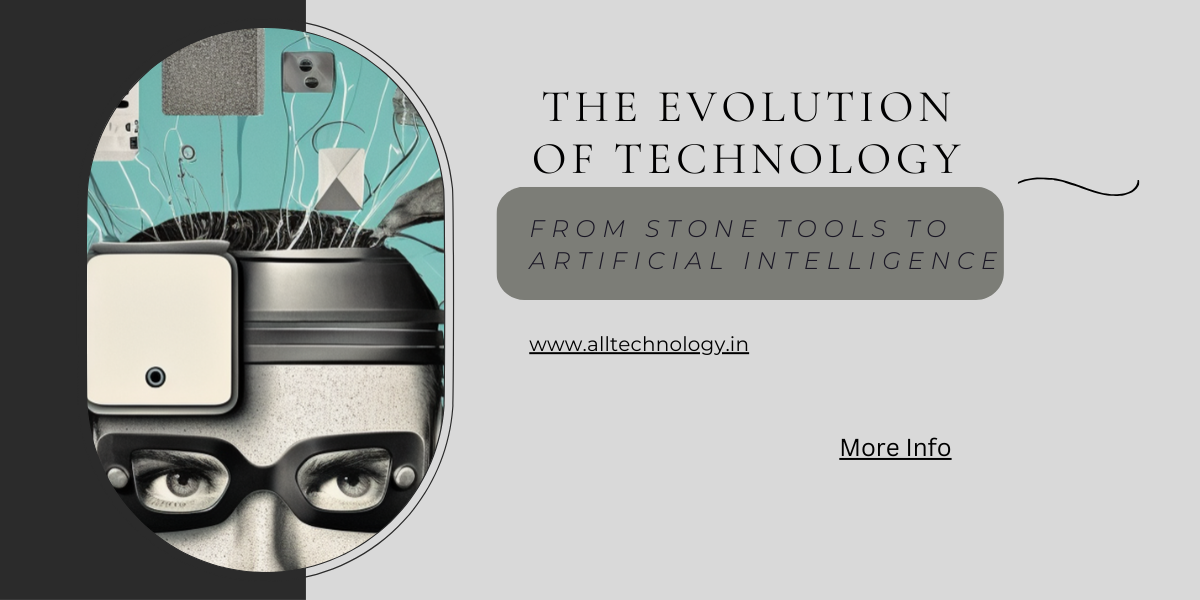Introduction
Hello Bloggers welcome alltechnology blog. In this blog you will learn The Evolution of Technology: From Stone Tools to Artificial Intelligence. In the grand tapestry of human history, the evolution of technology stands out as a testament to our ingenuity and creativity. From the humble beginnings of stone tools to the awe-inspiring advancements of artificial intelligence, our journey through time is marked by remarkable innovations that have reshaped the very fabric of society.

“Technological Evolution: From the Stone Age to Artificial Intelligence” is a book written by an AI that explores the history of human technology from its primitive roots to the present day. From a unique perspective, the book examines how technology has evolved over the years and how it has affected human society.
Perplexing Origins: Stone Tools
Our story begins millions of years ago, in the dim shadows of prehistory, where our ancestors first crafted stone tools. These rudimentary implements, fashioned from chipped rocks, represented a leap forward in our ability to manipulate the world around us. The complexity of these tools varied greatly, from simple hand axes to intricately crafted spearheads, showcasing early humans’ growing understanding of their environment.
The Rise of Civilization: Harnessing Fire and Metal
As the millennia passed, humanity’s mastery over technology grew ever more sophisticated. The discovery of fire allowed us to cook food, stay warm, and fend off predators, marking a pivotal moment in our history. With the advent of metalworking, our ability to shape the world around us reached new heights. Bronze and iron tools revolutionized agriculture, construction, and warfare, laying the foundation for the great civilizations of antiquity.
The Industrial Revolution: A New Age Dawns
The 18th century ushered in the Industrial Revolution, a period of unprecedented technological advancement. Steam engines powered factories, railways crisscrossed continents, and telegraph wires connected the world in ways previously unimaginable. This era saw the birth of modern industry, transforming societies and economies on a global scale.
The Digital Age: From Computers to Artificial Intelligence
In the latter half of the 20th century, the world witnessed the rise of the digital age. Computers, once the size of rooms, shrank to fit in the palm of a hand, revolutionizing communication, commerce, and entertainment. The internet connected billions of people, creating a vast digital network that continues to shape our lives in profound ways.
Artificial Intelligence: The Next Frontier
Today, we stand on the cusp of a new frontier in technological evolution: artificial intelligence. AI systems, capable of learning and adapting, are poised to revolutionize every aspect of our lives, from transportation to healthcare to entertainment. As we look to the future, the only certainty is that the march of technology will continue unabated, pushing the boundaries of what is possible and redefining the very essence of what it means to be human
Stone Age Ingenuity: Pioneering the Way
The Stone Age marked our first foray into technology, a time when humanity harnessed the power of nature to fashion tools for survival. From simple hand axes to more sophisticated arrowheads, our ancestors crafted implements that revolutionized hunting, agriculture, and warfare. Despite their simplicity, these tools laid the foundation for future technological advancements, showcasing humanity’s innate drive to innovate.
The Rise of Machinery: Steam, Steel, and Progress
As civilization progressed, so too did our technological prowess. The Industrial Revolution ushered in an era of unprecedented innovation, with steam engines and mechanical looms transforming industry and society. This period of rapid change saw the birth of modern infrastructure, shaping the world we live in today. The burstiness of this era was evident in its mixture of grand projects and intricate machinery, each pushing the boundaries of what was thought possible.
The Digital Revolution: Computing Power Unleashed
In the latter half of the 20th century, the world witnessed another revolution, this time driven by silicon and software. The invention of the microprocessor paved the way for the digital age, giving rise to computers, smartphones, and the internet. This era of rapid technological advancement brought with it a new wave of perplexity, as complex algorithms and data structures reshaped how we communicate, work, and live.
Artificial Intelligence: The Next Frontier
Today, we stand on the cusp of another technological leap forward: artificial intelligence. AI promises to revolutionize industries, from healthcare to transportation, with its ability to analyze data, recognize patterns, and make autonomous decisions. Yet, as we venture further into this realm, questions arise about the ethical implications and societal impacts of intelligent machines.
Balancing Perplexity and Burstiness: The Future of Technology
As we reflect on the evolution of technology, it becomes clear that both perplexity and burstiness have been integral to our progress. The complexity of our inventions mirrors the intricacies of the human mind, while the varied nature of technological advancements reflects our diverse interests and needs. As we look to the future, it is essential to maintain this balance, embracing complexity while also fostering innovation.
Navigating the Nexus: From Stone to Silicon
In the crucible of the modern age, the evolution of technology has reached unprecedented heights, culminating in the emergence of artificial intelligence as the quintessence of human achievement. With the advent of machine learning and neural networks, humanity stands at the threshold of a new era, where the boundaries between the natural and the artificial blur with tantalizing ambiguity.
Yet, even as we marvel at the wonders of silicon and circuitry, the echoes of antiquity linger in the corridors of the mind, reminding us of the timeless quest for understanding that unites humanity across the ages. In this nexus of past and future, perplexity and burstiness converge in a symphony of complexity, guiding us towards new horizons of discovery and innovation.
A Tapestry Unfolding
As we gaze upon the tapestry of human history, illuminated by the flickering light of technological progress, we are reminded of the enduring power of human creativity to transcend the limitations of the past and forge new pathways towards the future. In the intricate interplay of perplexity and burstiness, we find not only the essence of human endeavor but also the promise of a tomorrow shaped by the boundless potential of the human spirit.
Convergence at the Nexus of Artificial Intelligence
In the crucible of human endeavor, perplexity and burstiness converge at the nexus of Artificial Intelligence. Here, in the realm of machine learning and neural networks, humanity stands poised on the threshold of a new epoch of technological evolution.
AI, with its inscrutable algorithms and labyrinthine neural architectures, embodies the pinnacle of perplexity in the technological landscape. Yet, within its digital veins pulses the essence of burstiness, as diverse datasets and disparate inputs coalesce to form a symphony of synthetic intelligence.
From natural language processing to computer vision, AI heralds a new era where the boundaries between human and machine blur into obscurity. The complexities of human cognition find resonance in the silicon synapses of neural networks, giving rise to machines capable of learning, reasoning, and even dreaming.
1. The Primordial Sparks: Inception of Innovation In the dim corridors of antiquity, our forebears first kindled the flames of innovation with the crafting of stone tools. These primal implements, fashioned from the very earth itself, marked the dawn of humanity’s ascent towards mastery over the elements.
2. Wheels Turning, Empires Rising: The Age of Mechanical Marvels With the advent of the wheel, civilization surged forward, propelling humanity into the epoch of mechanical marvels. From the towering edifices of ancient civilizations to the intricate clockwork mechanisms of the Renaissance, each revolution of the cog heralded new heights of human achievement.
3. Electric Dreams: Illuminating the Path to Progress The discovery of electricity ignited a revolution that illuminated the path to modernity. With the flicker of a switch, the world was cast into a new age of enlightenment, where telegraphs crackled with messages across vast distances and light bulbs banished the shadows of the night.
4. The Digital Dawn: Navigating the Information Age As the digital era dawned, the world became enmeshed in a web of interconnectedness. Computers ceased to be mere machines, evolving into portals to vast realms of knowledge and communication. The birth of the internet heralded an age where information flowed freely, transcending barriers of time and space.
5. Beyond the Horizon: Charting the Course of Artificial Intelligence Today, we stand on the precipice of a new frontier: Artificial Intelligence. With algorithms that mimic the intricacies of the human mind, machines are poised to transcend the limitations of their creators. From self-driving cars to virtual assistants, AI permeates every facet of modern life, promising both unprecedented opportunities and profound challenges.
